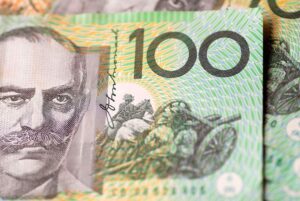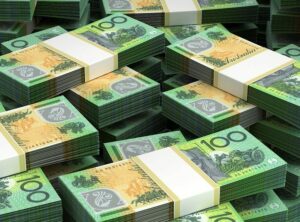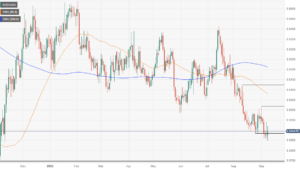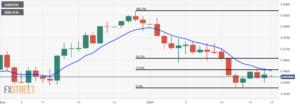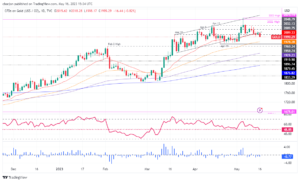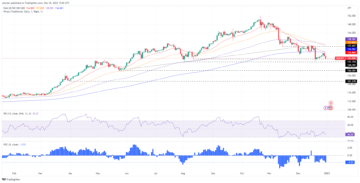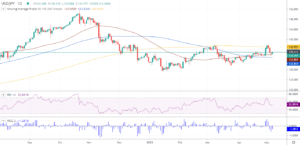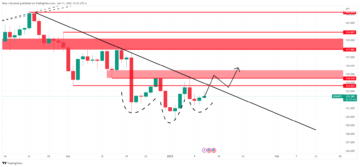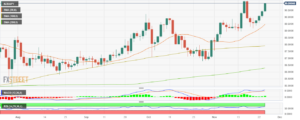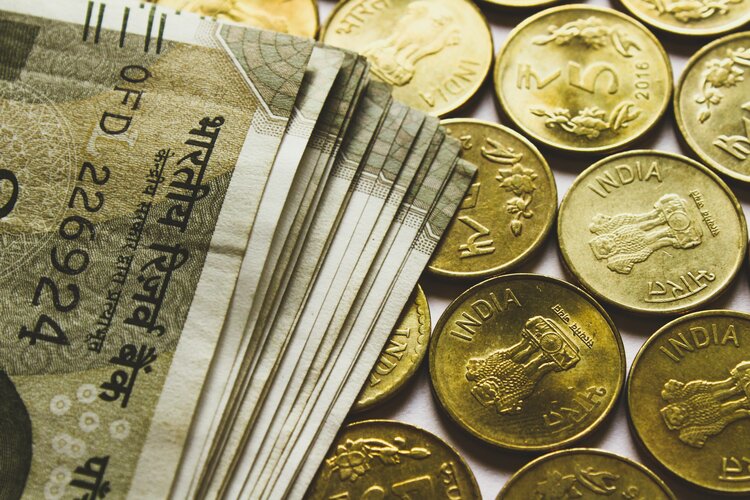
- Indian Rupee edges higher on the softer US Dollar.
- India’s GDP number is expected to expand to 6.8% in the July–September quarter compared with the previous year.
- India’s GDP Quarterly for Q2 and US Core Personal Consumption Expenditure Price Index (PCE) will be in the spotlight on Thursday.
Indian Rupee (INR) drifts higher on Thursday as dovish comments from Federal Reserve (Fed) officials undermine the US Dollar demand. Asia’s third-largest economy grew at 7.8% in the first quarter of the current fiscal year. India’s GDP number for the second quarter are scheduled to be released later in the day and is expected to grow at 6.8% in the July–September quarter compared with a year earlier.
Furthermore, Economic Affairs Secretary Ajay Seth expressed an optimistic view on the Indian economy on Wednesday, stating that the country is showing momentum and the growth rate in the second quarter is likely to be good. The Budget 2023-24 proposes to bring down the fiscal deficit to 5.9% of the GDP from 6.4% in the previous financial year. The government intends to decrease the budget deficit to less than 4.5% of GDP by 2025-26.
Investors will closely monitor India’s Gross Domestic Product (GDP) quarterly for the second quarter (Q2), which is scheduled for release on Thursday. Additionally, the development surrounding the last phase of state elections in India remains in focus, as a change in government might lead to policy modifications that could impact investors. On the US front, the Core Personal Consumption Expenditure Price Index (PCE) for October will be released, and this report could impact the expectations of the coming Fed decisions.
Daily Digest Market Movers: Indian Rupee strengthens amid the multiple headwinds
- Indian economy is projected to expand by 6.8% in the July-September quarter compared to the same period last year, according to a Reuters poll.
- Analysts anticipate that India’s Gross Domestic Product will expand by more than 6.0% next year, making it the fastest-growing major economy.
- Reserve Bank of India (RBI) projected growth of 6.5% for the period of July to September.
- Domestic demand in India continues to be the primary driver of economic activity, as external demand remains fragile.
- US Gross Domestic Product Annualized for the third quarter (Q3) grew 5.2% in the third quarter (Q3) from the previous reading of 4.9%, above the market consensus of 5.0%.
- The US Core Personal Consumption Expenditure Price Index (PCE) for October is expected to ease to 0.2% MoM and 3.5% YoY.
- Federal Reserve (Fed) Governor Michelle Bowman said she sought to keep alive the possibility of more rate hikes, raising concerns about the longevity of inflationary pressure.
- Fed Governor Christopher Waller stated that the Fed won’t need to raise rates further and may begin cutting rates if inflation continues to ease over the next three to five months.
Technical Analysis: Indian Rupee keeps the positive outlook intact
The Indian Rupee trades strongly on the day. The USD/INR pair has traded in a familiar range of 82.80–83.40 since September. According to the daily chart, the continuation of the upward bias remains valid as the pair holds above the key 100-day Exponential Moving Average (EMA) with an upward slope. Further upside looks favorable, backed by the 14-day Relative Strength Index (RSI) that holds above the 50.0 midline.
The immediate target for bulls to beat will emerge at the upper boundary of the trading range at 83.40. The additional upside filter to watch is the year-to-date (YTD) high of 83.47, and finally a psychological round figure of 84.00. On the flip side, the 83.00 psychological mark offered support to USD/INR. A decisive break below 83.00 will see a drop to the confluence of the lower limit of the trading range and a low of September 12 at 82.80, followed by a low of August 11 at 82.60.
US Dollar price today
The table below shows the percentage change of US Dollar (USD) against listed major currencies today. US Dollar was the weakest against the New Zealand Dollar.
| USD | EUR | GBP | CAD | AUD | JPY | NZD | CHF | |
| USD | -0.02% | -0.04% | -0.07% | -0.29% | 0.05% | -0.37% | -0.09% | |
| EUR | 0.02% | -0.04% | -0.05% | -0.27% | 0.06% | -0.36% | -0.10% | |
| GBP | 0.04% | 0.03% | -0.02% | -0.24% | 0.11% | -0.32% | -0.04% | |
| CAD | 0.07% | 0.06% | 0.02% | -0.22% | 0.12% | -0.31% | -0.02% | |
| AUD | 0.26% | 0.27% | 0.23% | 0.22% | 0.33% | -0.10% | 0.18% | |
| JPY | -0.04% | -0.05% | -0.10% | -0.11% | -0.34% | -0.40% | -0.12% | |
| NZD | 0.36% | 0.36% | 0.33% | 0.30% | 0.09% | 0.41% | 0.28% | |
| CHF | 0.11% | 0.08% | 0.04% | 0.02% | -0.19% | 0.14% | -0.27% |
The heat map shows percentage changes of major currencies against each other. The base currency is picked from the left column, while the quote currency is picked from the top row. For example, if you pick the Euro from the left column and move along the horizontal line to the Japanese Yen, the percentage change displayed in the box will represent EUR (base)/JPY (quote).
Indian Rupee FAQs
The Indian Rupee (INR) is one of the most sensitive currencies to external factors. The price of Crude Oil (the country is highly dependent on imported Oil), the value of the US Dollar – most trade is conducted in USD – and the level of foreign investment, are all influential. Direct intervention by the Reserve Bank of India (RBI) in FX markets to keep the exchange rate stable, as well as the level of interest rates set by the RBI, are further major influencing factors on the Rupee.
The Reserve Bank of India (RBI) actively intervenes in forex markets to maintain a stable exchange rate, to help facilitate trade. In addition, the RBI tries to maintain the inflation rate at its 4% target by adjusting interest rates. Higher interest rates usually strengthen the Rupee. This is due to the role of the ‘carry trade’ in which investors borrow in countries with lower interest rates so as to place their money in countries’ offering relatively higher interest rates and profit from the difference.
Macroeconomic factors that influence the value of the Rupee include inflation, interest rates, the economic growth rate (GDP), the balance of trade, and inflows from foreign investment. A higher growth rate can lead to more overseas investment, pushing up demand for the Rupee. A less negative balance of trade will eventually lead to a stronger Rupee. Higher interest rates, especially real rates (interest rates less inflation) are also positive for the Rupee. A risk-on environment can lead to greater inflows of Foreign Direct and Indirect Investment (FDI and FII), which also benefit the Rupee.
Higher inflation, particularly, if it is comparatively higher than India’s peers, is generally negative for the currency as it reflects devaluation through oversupply. Inflation also increases the cost of exports, leading to more Rupees being sold to purchase foreign imports, which is Rupee-negative. At the same time, higher inflation usually leads to the Reserve Bank of India (RBI) raising interest rates and this can be positive for the Rupee, due to increased demand from international investors. The opposite effect is true of lower inflation.
- SEO Powered Content & PR Distribution. Get Amplified Today.
- PlatoData.Network Vertical Generative Ai. Empower Yourself. Access Here.
- PlatoAiStream. Web3 Intelligence. Knowledge Amplified. Access Here.
- PlatoESG. Carbon, CleanTech, Energy, Environment, Solar, Waste Management. Access Here.
- PlatoHealth. Biotech and Clinical Trials Intelligence. Access Here.
- Source: https://www.fxstreet.com/news/usd-inr-trades-weaker-all-eyes-on-the-indian-gdp-us-pce-data-202311300346
- :has
- :is
- $UP
- 1
- 11
- 12
- 2%
- 32
- 40
- 41
- 50
- 60
- 7
- 80
- 84
- a
- About
- above
- According
- actively
- activity
- addition
- Additional
- Additionally
- adjusting
- Affairs
- against
- alive
- All
- along
- also
- Amid
- an
- analysis
- and
- Animate
- annualized
- anticipate
- ARE
- AS
- asia
- At
- AUGUST
- average
- backed
- Balance
- Bank
- Bank of India
- base
- BE
- beat
- begin
- being
- below
- benefit
- bias
- borrow
- Box
- Break
- bring
- budget
- Bulls
- by
- CAN
- change
- Changes
- Chart
- Christopher
- Christopher Waller
- closely
- Column
- coming
- comments
- comparatively
- compared
- Concerns
- conducted
- confluence
- Consensus
- consumption
- content
- continuation
- continues
- Core
- Cost
- could
- countries
- country
- crude
- Crude oil
- currencies
- Currency
- Current
- cutting
- daily
- data
- day
- decisions
- decisive
- decrease
- DEFICIT
- Demand
- dependent
- Devaluation
- Development
- difference
- Digest
- direct
- displayed
- Dollar
- Domestic
- Dovish
- down
- driver
- Drop
- due
- each
- Earlier
- ease
- Economic
- Economic growth
- economy
- economy grew
- effect
- Elections
- EMA
- emerge
- ends
- Environment
- especially
- EUR
- Euro
- eventually
- example
- exchange
- Exchange rate
- Expand
- expanded
- expectations
- expected
- exponential
- exponential moving average
- exports
- expressed
- external
- Eyes
- facilitate
- factors
- familiar
- FAQ
- favorable
- Fed
- Federal
- federal reserve
- Figure
- filter
- Finally
- financial
- First
- Fiscal
- five
- Flip
- Focus
- followed
- For
- foreign
- foreign investment
- forex
- Forex markets
- from
- front
- further
- FX
- FX markets
- GDP
- generally
- good
- Government
- Governor
- greater
- grew
- gross
- Grow
- Growth
- help
- High
- higher
- highly
- Hikes
- holds
- Horizontal
- HTTPS
- if
- immediate
- Impact
- imports
- in
- include
- increased
- Increases
- index
- india
- Indian
- inflation
- inflation rate
- Inflationary
- inflows
- influence
- influencing
- Influential
- intends
- interest
- Interest Rates
- International
- international investors
- intervention
- investment
- Investors
- IT
- ITS
- Japanese
- Japanese Yen
- jpg
- July
- Keep
- Key
- Last
- Last Year
- later
- lead
- leading
- Leads
- left
- less
- Level
- likely
- LIMIT
- Line
- Listed
- longevity
- LOOKS
- Low
- lower
- maintain
- major
- Making
- map
- mark
- Market
- Markets
- May..
- michelle
- might
- Modifications
- module
- mom
- Momentum
- money
- Monitor
- months
- more
- most
- move
- Movers
- moving
- moving average
- multiple
- Need
- negative
- New
- New Zealand
- next
- number
- october
- of
- offered
- offering
- officials
- Oil
- on
- ONE
- opposite
- Optimistic
- Other
- Outlook
- over
- overseas
- pair
- particularly
- pce
- peers
- percentage
- period
- personal
- phase
- pick
- picked
- Place
- plato
- Plato Data Intelligence
- PlatoData
- policy
- poll
- positive
- possibility
- pressure
- previous
- price
- primary
- Product
- Profit
- projected
- proposes
- psychological
- purchase
- Pushing
- Q2
- Q3
- Quarter
- quote
- raise
- raising
- range
- Rate
- rate hikes
- Rates
- RBI
- Reading
- real
- reflects
- relative
- relative strength index
- Relative Strength Index (RSI)
- relatively
- release
- released
- remains
- report
- represent
- Reserve
- reserve bank
- Reserve Bank of India
- Reuters
- Role
- round
- ROW
- rsi
- s
- Said
- same
- scheduled
- Second
- second quarter
- secretary
- see
- sensitive
- September
- set
- she
- showing
- Shows
- side
- since
- Slope
- So
- sold
- sought
- Spotlight
- stable
- starts
- State
- stated
- stating
- strength
- Strengthen
- Strengthens
- stronger
- strongly
- support
- Surrounding
- table
- Target
- than
- that
- The
- the Fed
- The Reserve Bank of India
- their
- Third
- this
- three
- Through
- thursday
- time
- to
- today
- top
- trade
- traded
- trades
- Trading
- true
- Undermine
- Upside
- upward
- us
- US Dollar
- USD
- usd/inr
- usually
- valid
- value
- View
- was
- Watch
- Wednesday
- WELL
- which
- while
- will
- with
- year
- Yen
- you
- Zealand
- zephyrnet

